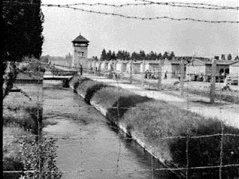H/T Zach
This is cross post by Martin Krossel at The Huffington Post

Seventy years ago this month, Jews, mainly from Romania and provinces that it acquired through the post-World War I Treaty of Versailles, were deported to the Ukrainian territory of Transnistria. As Nazi Germany marched on the Soviet Union, it left their Romanian allies to administer Transnistria.
Between 150,000 and 250,000 Jews were murdered there by the authorities between 1941 and 1944.
Last weekend, Transnistria survivors in Toronto held their annual public memorial gathering. The numbers of both attendees and organizers are dwindling with the passage of time.
That’s unfortunate. The slaughter of Jews in Transnistria is among the least known aspects of the Holocaust.
This is attributable to many factors. The Ukraine was far away from the central theatre of the Holocaust in Germany and Poland. In Transnistria the Germans stayed in the background leaving much of the dirty work to enthusiastic Ukrainian and Romanian henchmen. Also, Transnistria had few gas chambers or well-organized killing operations.
Most of the Jewish victims died while being transported in cattle cars; on long forced marches that went for days or even weeks; arbitrary shootings; or, from hunger and disease in the concentration camps and ghettos that were the direct result of their persecutors’ deliberate policies of starvation and deprivation.
Both speakers at the commemoration portrayed the Arab-Israel conflict as a continuation of the Jews’ struggle for survival against the Nazis.
That’s not off the mark. Arguably the father of Palestinian nationalism, the Mufti of Jerusalem Haj Amin al-Husseini, spent World War II in Berlin where, among other activities on behalf of the Nazis, he made anti-Semitic radio speeches in Arabic, targeting audiences in the Middle East.
These speeches were supposed to inspire local Muslin populations to violently attack Jews once the Germans conquered the Middle East and North Africa. Historian Jeffrey Herf who studies Nazi propaganda in the Arab world points out that the Middle East was one of the few places in the world where accused war criminals could settle after World War II without hiding their old Nazi identities. Popular anti-Semitism has disappeared in subsequent years.
However, viciously anti-Semitic material is spread through the government-controlled media and in school texts and curricula in the Palestinian Authority and the rest of the Arab world.
In Monday’s National Post, Abraham Cooper dean of the Simon Wiesenthal Center in Los Angeles, told the story of David Gerbi, a Libyan Jew who was forced to flee his country during Gaddafi’s rule, but who recently returned to test the new government’s commitment to the establishment of a moderate Muslim regime that would respect the norms of human rights.
But Gerbi found that some of the locals in the new Libya warned him to leave for his own safety, while others demonstrated in front of his hotel for a whole day shouting threatening slogans such as “No Jews or Zionists.” Eventually, Gerbi was evacuated from “free” Libya in an Italian military aircraft.
In the Arab-Israeli conflict, disputes over borders, Jewish settlements and even the status of Jerusalem are all peripheral. Like their brethren in Nazi Europe, Israel’s Jews are struggling for the physical survival. When the popular Arab animus against Jews is shed, all other disputes could be resolved easily.
Related articles
- Deputy Editor of ‘Comment is Free’ expresses concern for Ben White’s “reputation” on Twitter (cifwatch.com)
- Guardian issues ‘progressive in good standing’ card to Carlos Latuff: racist and anti-Semite (cifwatch.com)
- The Guardian’s Jonathan Freedland, Hebron and the logic of ethnic cleansing (cifwatch.com)
- On why many liberals continue to ignore explicit anti-Semitism in the Palestinian media (cifwatch.com)




